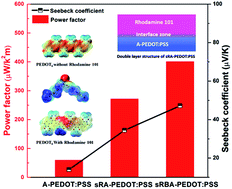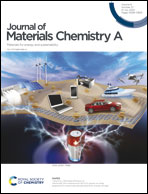Thermoelectric polymer films with a significantly high Seebeck coefficient and thermoelectric power factor obtained through surface energy filtering†
Abstract
Thermoelectric (TE) polymers have unique advantages in converting heat into electricity. But their Seebeck coefficient is lower than that of inorganic TE materials by about one order of magnitude. Here, surface energy filtering is proposed to significantly enhance the Seebeck coefficient of TE polymers. The as-prepared poly(3,4-ethylenedioxythiophene):poly(styrenesulfonate) (PEDOT:PSS, the most popular TE polymer) films from aqueous solution have a low Seebeck coefficient of 15–18 μV K−1 and a power factor of ∼0.008 μW m−1 K−2. Depositing Rhodamine 101, a zwitterion, on PEDOT:PSS films can enhance the Seebeck coefficient to 47.2 μV K−1 and the power factor to 401.2 μW m−1 K−2. The Rhodamine 101 effect on the Seebeck coefficient is consistent with its effect on the work function of PEDOT:PSS. The enhancement in the Seebeck coefficient is ascribed to the dipole moment of Rhodamine 101 and the interfacial dipole moment formed at the surface of the PEDOT:PSS films. This is confirmed by theoretical simulations. We call this mechanism surface energy filtering. Surface energy filtering can increase the mean energy of the transporting carriers and thus the Seebeck coefficient of the PEDOT:PSS films while only slightly affecting the electrical conductivity. It can thus significantly enhance the Seebeck coefficient and the power factor simultaneously.



 Please wait while we load your content...
Please wait while we load your content...